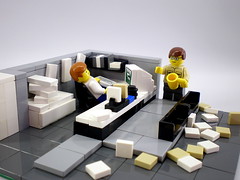 Due to the current recession, many companies find themselves cutting back in an attempt to reduce costs. One common measure used by many employers is reduction of office space. A 2011 Jones Lang Lasalle survey found that 73% of global companies are consolidating offices as an effective cost cutting measure. Workers in these companies are often forced to give up their offices and move into a shared workspace. It is essential for us to be aware of the challenges our employees are faced with when moving to a new environment.
Due to the current recession, many companies find themselves cutting back in an attempt to reduce costs. One common measure used by many employers is reduction of office space. A 2011 Jones Lang Lasalle survey found that 73% of global companies are consolidating offices as an effective cost cutting measure. Workers in these companies are often forced to give up their offices and move into a shared workspace. It is essential for us to be aware of the challenges our employees are faced with when moving to a new environment.
While cost savings and bottom lines are often the reason for downsizing, there are a plethora of benefits that come with decreased distance. Being in a smaller or shared office necessitates increased engagement. When our workers develop closer bonds, it improves the mood and environment of the entire office. Employees will feel more connected to the office and will strive to be successful both personally and as team workers. Work will no longer just be a means of support; it will be a way to succeed and feel accomplished! According to Keith Perske, the President of workplace consultant agency Group 5 Consulting says, “It makes you feel more loyal to a company if there’s some energy or buzz.” Perske advocates downsizing to improve communication and relationships, leading to better teamwork and ultimately increased productivity.
We all know that significant changes can negatively affect the harmony of a workplace. To make the transition easier and successfully downsize without harming individual or group productivity, keep the following guidelines in mind:
- My dance space, your dance space – Employees in small businesses that are sharing space should discuss and create clearly outlined guidelines. These should both provide examples of what isn’t permitted (i.e., loud music), as well as basic guidelines (i.e., headphones are our friends). Providing clear cut boundaries will minimize conflict and help employees avoid behavior that is bothersome to others.
- Recognize Strengths – Having other people around to help assist you with numerous tasks is always helpful. Many times co-workers can offer assistance to each other. For instance, if an employee is having issues with something on his computer he may be able to turn to a tech-savvy co-worker. However, it is important to understand who to ask for help in each situation. Going around the office asking for help is unnecessarily time consuming and disruptive to the work flow. Noticing your colleagues’ interests and line of work, will often help you gauge his/her abilities and strengths but you must recognize the appropriate time and place to ask for assistance.
- It’s a Sensitivity Thing – Sharing an office often leads to more interaction between employees. Very often, co-workers find this increased social interaction helps improve their comfort in the office and may even boost productivity. However, it is still important to be sensitive to each others’ work flow. When someone in the office is on an important business call, joking with them, or even asking them a question is inappropriate. Placing items on a workers desk that aren’t relevant to his/her work is also not a good idea. Looking over a co-workers shoulder while s/he is typing an email is another form of intrusive behavior.
- Driven to Distraction – Certain behaviors that may be offensive to your co-workers or cause personal debates (i.e., political opinions) should be avoided. Making personal calls in the office is often distracting to those around you. Being smart and aware of your surroundings will help avoid unnecessary conflict and wasted time.
When downsizing our companies, it is important to recognize the new challenges our employees are faced with. A successful moving plan will help us avoid catastrophe and instead enrich the work experience for all of us, both employer and employee. By prompting our workers to follow the above guidelines, we can help ensure a positive, beneficial transition to our new maximized office space!
